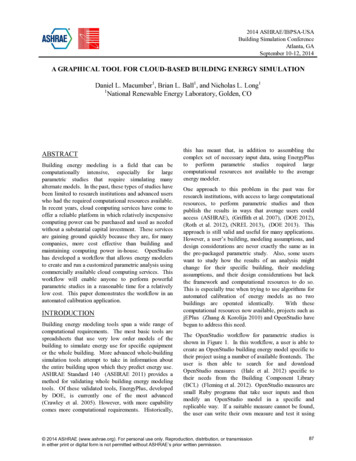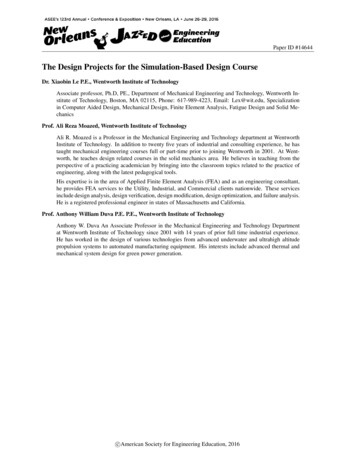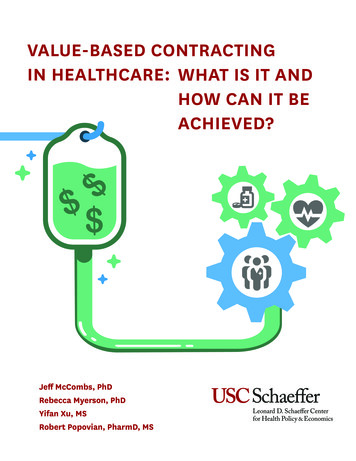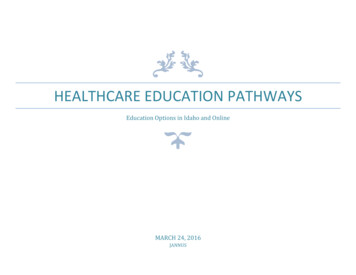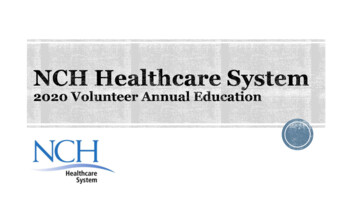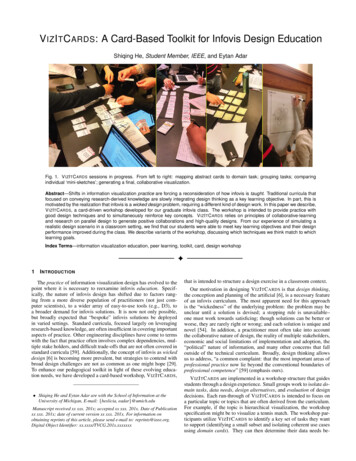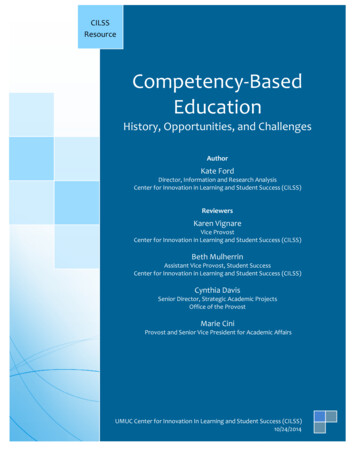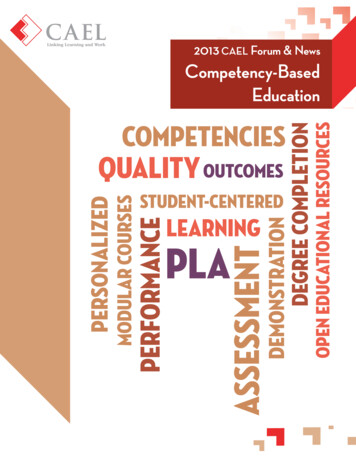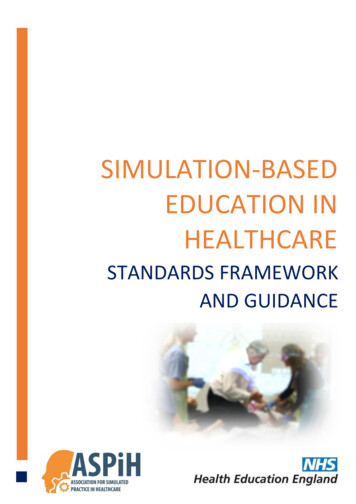
Transcription
SIMULATION-BASEDEDUCATION INHEALTHCARESTANDARDS FRAMEWORKAND GUIDANCE
AcknowledgementsMany people and organisations have contributed to the development of these Standards.We would like to record our appreciation of the time and effort spent by all those who provided feedback,advice and guidance over the two years it has taken to develop this framework. The engagement andcontribution by such a breadth of organisations and individuals has exceeded all expectations’.We will continue to need your support, engagement and willingness to share experiences to keep thequality process moving forward and we will continue to seek open engagement with all parties to makesure the standards work for the simulation community as ‘providers’, as well as others such as regulators,professional bodies and commissioners.The partnership between ASPiH and HEE will ensure the most effective delivery and adoption during 2017and beyond.The ASPiH Standards Project TeamChairDr Makani Purva, Hull Royal InfirmaryAdvisorsProfessor Bryn Baxendale, Trent Simulation CentreEmma Scales, Manager HEE TELTeam LeaderAndy Anderson Chief Executive Officer ASPiHProject Manager, Northern Region Jane NicklinProject Manager, Southern Region Susie HowesClinical AdvisorAndrew Blackmore, Hull Royal Infirmary
SIMULATION-BASED EDUCATION IN HEALTHCARE– STANDARDS FRAMEWORK AND GUIDANCETable of ContentsExecutive Summary . 2 Page 1Introduction . 3About ASPIH . 3Background . 3Intended Use and Scope . 3Accreditation and Further Development . 4Theme 1: Faculty. 4Context . 4Guidance . 5Theme 2: Technical Personnel . 7Context . 7Theme 3: Activity . 8Programme . 8Context . 8Guidance . 9Procedural Skills . 10Context . 10Guidance . 10Assessment . 12Guidance . 13In Situ Simulation (ISS) . 14Guidance . 15Theme 4: Resources . 16Guidance . 17Management, Leadership and Development . 17STANDARDS SUMMARY. 20References . 21Glossary . 24 Copyright Association for Simulated Practice in Healthcare (ASPiH) 2016All Rights Reserved
SIMULATION-BASED EDUCATION IN HEALTHCARE– STANDARDS FRAMEWORK AND GUIDANCEExecutive SummaryThis document is the result of a 2-year programme to develop a National Standards Framework forSimulation-based Education (SBE). Following the earlier National Simulation Development Project [1],Health Education England (HEE) recognised the need for standards in this field and part-funded theAssociation for Simulated Practice in Healthcare (ASPiH) to produce an initial draft document that has Page 2been further developed into this final framework through consultation, research and expert input. TheASPiH Standards Project Team has consulted with over 40 pilot sites, received feedback from over 80individual practitioners and engaged with experts from key stakeholder organisations to ensure thedocument is relevant and applicable across the widest possible range of SBE applications.The Framework describes the attributes required to design and deliver effective simulation-basededucation. It is defined by shared values, beliefs and principles from across the healthcare simulationdomain and reflects best practice in SBE. A key objective was to produce a document that drivesimprovements in SBE practice, providing advice and information as well as a first step towards anagreed quality assurance process for SBE. The underpinning aim was to develop a generic frameworkthat would be applicable to as many areas of practice as possible but not so bland as to be ineffective.The Framework document comprises two parts: a set of Standards and supporting Guidance. Thisinformation has been grouped under four main headings or ‘themes’: Faculty, Technical Personnel,Activity and Resources. The Standards in each theme are written as statements identifying bestpractice in SBE while the Guidance section underpins the Standards, describing detailed evidence orpractice that could support achievement of the standard together with suggested measures andreferences.The Framework is intended to provide quality assurance for providers, regulators, professional bodiesand commissioners and has the following wider benefits: Provides a common framework and defined standards that can be applied within educationaland healthcare sectorsProvides a clear focus on improving the quality of simulation-based education and practiceInforms future policy and practice amongst regulatory and professional bodiesSupports better informed and more consistent commissioning practicesStrengthens opportunities and benefits of peer networking, collaboration and improvementProvides a more robust platform on which to develop the evidence base that will furtherdefine best practice Copyright Association for Simulated Practice in Healthcare (ASPiH) 2016All Rights Reserved
SIMULATION-BASED EDUCATION IN HEALTHCARE– STANDARDS FRAMEWORK AND GUIDANCEIntroductionAbout ASPIHThe Association for Simulated Practice in Healthcare (ASPiH) is the national learned body that focuseson the development and application of simulation-based education (SBE) and technology-enhancedPage 3learning (TEL) in the United Kingdom. It is a not-for-profit company bringing together a multiprofessional membership drawn from higher education, clinical practice and academic disciplinesallied to healthcare to improve safety and quality of care provided to patients.BackgroundIn 2012/13 ASPiH conducted a National Simulation Development Project [1], supported by HealthEducation England (HEE) and the Higher Education Academy (HEA) to map the resources andimplementation of SBE and TEL across the United Kingdom. One of the key issues identified in theresultant report was the need for standards of practice and national guidance for SBE related to qualityindicators. There was a desire for any standards to be relevant and of value to the increasing numberand breadth of institutions, departments and individuals designing and delivering SBE.ASPiH produced a draft Standards document in 2015 and conducted an initial consultation, feedbackfrom which showed the document required further development. In early 2016, HEE funded an ASPiHStandards Project Team that has consulted widely on a revised document with the ASPiH community,educational professionals in the field of SBE, experts in undergraduate and postgraduate curricula andthose with expertise in human factors and ergonomics. The resultant Framework incorporates bestpractice from published evidence and is extensively mapped to existing quality assurance processescurrently in use across the UK and internationally, including the General Medical Council (GMC) [1],the Nursing and Midwifery Council (NMC) [2], the General Pharmaceutical Council (GPhC) [3] and theHealth and Care Professions Council (HCPC) [4].Intended Use and ScopeThe multi-professional nature of the ASPiH community has enabled the Framework to be built aroundresponses from the widest possible community of practice. It is intended for use by healthcareprofessionals involved in SBE at pre-and post-registration, in Trust and University environments orother facilities and should be applicable to both novice and experienced simulation faculty. In thiscontext, SBE refers to a spectrum of activity extending from simple role playing, through to simulatedpatients, part-task trainers, hybrid models, full body manikins and complex simulated environments.ASPiH is aware that some UK networks involved in SBE have developed and are using regionalstandards/guidelines to aid the design and delivery of high quality SBE. ASPiH has reviewed theseinitiatives and, where relevant, incorporated similar structures and elements into the final StandardsFramework. Our key aim has been to complement these initiatives and produce a National Frameworkinto which local practice standards and procedures could fit. Where data already exists on compliancewith existing local standards, this could be used as evidence to support and comply with the NationalFramework.The Standards incorporated into the Framework are not mandatory at this stage of development inthe science of simulated practice. ASPIH hopes the standards will be used as a tool to improvesimulated practice and serve as an aspirational document for those developing and delivering SBE.The document should not be seen as prescriptive and the intention is not to stifle innovation or Copyright Association for Simulated Practice in Healthcare (ASPiH) 2016All Rights Reserved
SIMULATION-BASED EDUCATION IN HEALTHCARE– STANDARDS FRAMEWORK AND GUIDANCEcreativity. The use of the word ‘Standards’ in the context of this Framework is fundamentally differentfrom that used by professional bodies in defining their requirements for education, training andpatient safety. However, these Standards do provide a key step in developing a quality assuranceprocess for SBE.Accreditation and Further DevelopmentPage 4It is intended that the Standards project should now move into an adoption phase. ASPiH plans tointroduce a draft Accreditation process early in 2017 to facilitate self-evaluation against theFramework. This will enable all practitioners and their organisations to use the Standards Frameworkin a consistent way and identify how their practice benchmarks against both the Standards andGuidance. During the adoption phase, quality data will be gathered to measure progress andoutcomes which in turn will inform the next steps in the process and, potentially, a further iterationof the Framework recognising areas of practice that are missing or where achievement of the Standardis shown to be very challenging. In parallel to this adoption of the Standards by the simulationcommunity, HEE will be using the document to conduct consultation with other groups such as Deans,Commissioners and Regulators to discuss their potential utility by these groups in the future.Theme 1: FacultyContextSimulation programme faculty members are recruited from a pool of educators who may beexperienced in simulation-based education, content experts in the subject being delivered, or both.It is widely accepted that the debriefing process is the most important component of
It is defined by shared values, beliefs and principles from across the healthcare simulation domain and reflects best practice in SBE. A key objective was to produce a document that drives improvements in SBE practice, providing advice and information as well as a first step towards an agreed quality assurance process for SBE. The underpinning aim was to develop a generic framework that would .

